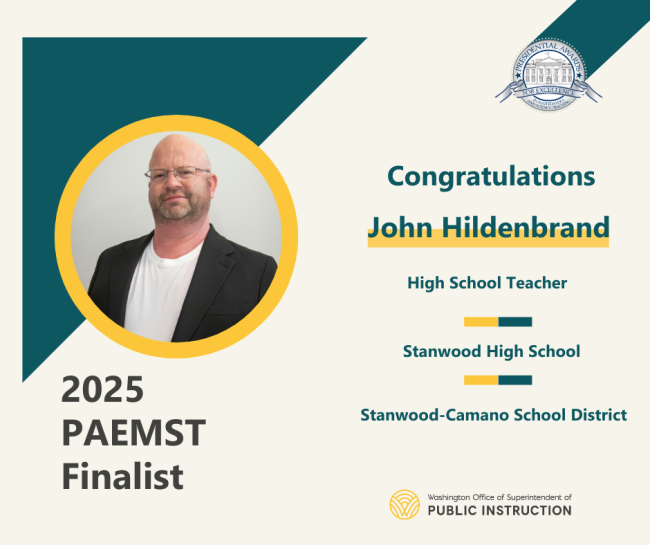John Hildenbrand
Media Contact
Katy Payne she/her
360-764-0201

What has been your personal journey on the way to excellence in teaching math/science?
My journey into teaching started long before my first job. In 7th grade, a teacher recognized my strength in math and encouraged me. Later, in high school, another teacher made math engaging and relevant, reinforcing my passion. My mom, also a teacher, set an incredible example. Looking back, I've always known I was meant to be a math teacher. Every experience—from my days as a student to my time teaching in the classroom—has only strengthened that belief.
Teaching across four states and multiple districts has given me a diverse perspective on education. Each experience has shaped my understanding of how students learn and what truly works in the classroom. These experiences have also pushed me to explore new strategies to make learning more meaningful. About 15 years ago, a colleague introduced me to student-led investigative learning, and it completely transformed my approach. Seeing students take ownership of their learning and engage deeply with the material was a turning point for me.
What is one concept that excites your students and why?
One concept that really excites my students is exploring the relationship between exponential functions and logarithms. There's something about seeing how these two ideas connect that just clicks for them, and their excitement fuels my own passion for teaching. A highlight of our exploration is a multi-day project on the water hyacinth plant. Students examine its rapid growth, linking it to exponential and logarithmic functions. What makes this project even more engaging is its integration with biology, showing students how math isn't just abstract but a powerful tool to understand the world. The best part is that this project often sparks curiosity beyond the classroom. I've had students ask for more information about STEM fields and even take the initiative to explore them on their own.
How do your lesson planning and teaching practices engage and support all students?
When planning lessons, I focus on student collaboration, ensuring that all students have opportunities to share their perspectives and learn from one another. I strive to create a classroom environment where students feel comfortable taking academic risks, knowing their ideas are valued and that mistakes are part of the learning process. A key part of my teaching is movement and active engagement. Whether through group problem-solving, interactive activities, or discussions with different classmates, movement helps keep students energized and involved. I also use multiple representations such as manipulatives, group vertical whiteboards, and technology to address students' diverse backgrounds, knowledge, and experiences. To ensure all students succeed, I differentiate instruction by providing scaffolding for those who need extra support while offering enrichment for students ready for more challenges. Creating a dynamic, inclusive learning environment not only makes lessons more engaging but also builds students' confidence in their thinking.
How do the math and science concepts and skills you are teaching students help to prepare them for later learning, careers, and life?
Students need to see the importance of every concept they learn. I want them to recognize how each idea connects to what they've learned before and how it builds toward what's coming next. When students see these connections, we can move past the question, "When will we ever use this?" and instead focus on how math is woven into everything around us. I like to think of learning like music: You don't just hear a single note; you experience the whole song. Math, like music, is all about patterns, relationships, and connections. Every concept adds another layer to the bigger picture. Beyond the classroom, math and science build critical thinking, problem-solving, and analytical skills that prepare students for a range of careers—some of which don't yet exist.
What can math and science teachers do to make those disciplines more culturally sustaining for students with diverse identities and experiences?
Connecting learning to students' experiences is essential. By analyzing local data—such as the cost of goods, population changes, or environmental factors—students can apply math to real-world issues that directly affect their communities. Representing this data in various ways and predicting trends allows students to take ownership of their learning and see it active in their own lives. Collaboration is also important. I encourage students to work together on algebraic problems, share strategies, and learn from one another. These discussions create a sense of community, helping students recognize that multiple approaches can lead to understanding.
What advice would you give to parents, families, or caregivers who want to support their students’ math and science learning?
One key message to reinforce is that effort is more important than always getting the right answer. Encouraging a growth mindset, where mistakes are seen as valuable learning opportunities, helps students build resilience and avoid frustration. Talking positively about math at home is essential. Instead of focusing on past struggles, parents can highlight math's usefulness in everyday life—like measuring ingredients, budgeting, or strategizing in games. Parents can also motivate students by discussing how math connects to various careers, from engineering to creative fields like architecture. Showing the wide range of possibilities can spark students' interest in the subject. Finally, maintaining open communication with teachers is key. Parents should feel comfortable discussing their child's progress, asking about areas of struggle, and seeking additional resources.






